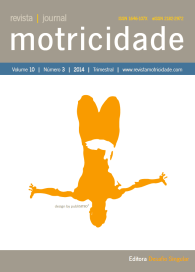Assessing adolescents’ sport participation motives: psychometric evaluation of BRSQ
DOI:
https://doi.org/10.6063/motricidade.3194Abstract
The aim of the study was to examine the factorial structure and validity of Behavioral Regulation in Sports Questionnaire (BRSQ – Lonsdale Hodge & Rose, 2008). The proposed nine dimensional motivation model by Lonsdale et al. (2008) investigated: i) amotivation, ii) external regulation, iii) introjected regulation, iv) identified regulation, v) integrated regulation, vi) IM-general, vii) IM to know, viii) IM to experience stimulation and ix) IM to accomplish. One hundred and fifty-eight children aged 10 to 13 years old, all active members of private volleyball, football and basketball sport academies in a Greek city, completed the questionnaire. The age groups were chosen based on the early period of adolescence when a person seems to formulate his/her decision about whether to continue participating in a sport, choose another or abandon exercise in general. The scale was translated into Greek using the back-translation procedure. A confirmatory factor analysis (CFA) did not provide adequate support for the factorial validity of the motivational model. The data were then analyzed with an exploratory factor analysis and internal consistency through Cronbach alpha. Exploratory Factor Analysis revealed six out of the initial nine motivational factors. The theoretical and practical implications of these results are discussed.Downloads
Published
Issue
Section
License
The authors of submitted manuscripts must transfer the full copyright to Journal Motricidade / Desafio Singular Editions. Granting copyright permission allows the publication and dissemination of the article in printed or electronic formats and copyrights start at the moment the manuscript is accepted for publication. It also allows Journal Motricidade to use and commercialize the article in terms of licensing, lending or selling its content to indexation/abstracts databases and other entities.
According to the terms of the Creative Commons licence, authors may reproduce a reasonable number of copies for personal or professional purpose but without any economic gains. SHERPA/RoMEO allows authors to post a final digital copy (post-printing version) of the article in their websites or on their institutions' scientific repository.


